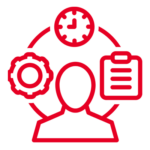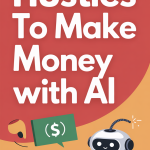The artificial intelligence revolution is not coming—it is here, and it represents the most significant economic opportunity of our lifetime. While many people are still trying to understand what AI means for their future, forward-thinking entrepreneurs are already building profitable businesses around this transformative technology. The question is not whether AI will reshape the economy, but whether you will position yourself to benefit from this unprecedented shift.
Consider this: every major technological revolution has created millionaires and billionaires from those who recognized the opportunity early. The internet boom of the 1990s created companies like Amazon and Google. The social media explosion of the 2000s gave birth to Facebook and Twitter. The mobile revolution that followed created entire industries around app development and mobile commerce. Today, we stand at the precipice of the AI revolution, and the opportunities are even more vast and accessible than ever before.
What makes the AI opportunity particularly compelling is its democratizing nature. Unlike previous technological revolutions that required significant capital, technical expertise, or insider connections, AI tools have become remarkably accessible to ordinary individuals. You do not need a computer science degree, millions in venture capital, or years of experience to start building a profitable AI-powered business. All you need is the willingness to learn, adapt, and take action while the market is still in its early stages.
The three side hustles outlined in this comprehensive guide represent proven business models that are already generating substantial income for entrepreneurs worldwide. These are not theoretical concepts or get-rich-quick schemes, but legitimate business opportunities that leverage the growing demand for AI solutions across various industries. Each of these ventures can be started with minimal upfront investment and scaled to generate thousands of dollars in monthly recurring revenue.
The AI Chatbot Consulting Revolution: Building Digital Employees for Modern Businesses
The first and perhaps most immediately profitable AI side hustle involves creating and managing chatbots for businesses that are struggling to keep up with customer inquiries and support requests. This opportunity exists because of a fundamental shift in consumer expectations and business operations that has been accelerated by the widespread adoption of AI technology.
Modern consumers expect instant responses to their questions, regardless of the time of day or the complexity of their inquiry. Traditional customer service models, which rely on human agents working during business hours, are increasingly inadequate for meeting these expectations. Businesses are losing customers and revenue because they cannot provide the immediate, round-the-clock support that today’s market demands. This is where AI chatbots become invaluable business assets rather than mere technological novelties.
The beauty of the chatbot consulting business lies in its scalability and recurring revenue potential. Unlike one-time service offerings, chatbots require ongoing maintenance, updates, and optimization, creating opportunities for long-term client relationships and predictable monthly income. Furthermore, the technology has evolved to the point where creating sophisticated chatbots no longer requires programming knowledge or expensive software licenses.
Understanding the Market Demand for AI Customer Service Solutions
The demand for AI-powered customer service solutions has exploded across virtually every industry. Small and medium-sized businesses, in particular, are eager to implement these technologies because they offer a way to compete with larger corporations without hiring extensive customer service teams. A well-designed chatbot can handle hundreds of customer interactions simultaneously, providing consistent, accurate responses while freeing human employees to focus on more complex tasks that require emotional intelligence and creative problem-solving.
Local service businesses represent an especially lucrative target market for chatbot services. Hair salons, dental offices, automotive repair shops, fitness centers, restaurants, and retail stores all receive similar types of inquiries on a daily basis. Customers want to know about business hours, pricing, availability, location details, and service offerings. These are exactly the types of questions that AI chatbots excel at answering quickly and accurately.
The financial impact of implementing chatbots extends far beyond simple cost savings on customer service staff. Businesses that deploy effective chatbots often see improvements in lead conversion rates, customer satisfaction scores, and overall operational efficiency. When potential customers can get immediate answers to their questions, they are more likely to make purchases or book appointments. This creates a compelling value proposition that makes business owners willing to pay premium prices for chatbot implementation and management services.

Mastering No-Code Chatbot Development Platforms
The technical barrier to entry for chatbot development has been virtually eliminated by the emergence of sophisticated no-code platforms. Tools like BotPress, FlowiseAI, and Chatfuel allow entrepreneurs to create complex, intelligent chatbots without writing a single line of code. These platforms provide drag-and-drop interfaces, pre-built templates, and integration capabilities that make it possible to deploy professional-grade chatbots in a matter of hours rather than weeks or months.
BotPress, in particular, has emerged as a favorite among chatbot consultants because of its powerful natural language processing capabilities and extensive integration options. The platform allows you to train chatbots using existing business information, such as website content, frequently asked questions, and product catalogs. This means you can create highly relevant, context-aware chatbots that provide accurate information specific to each client’s business.
The training process involves feeding the chatbot relevant information about the business and then testing its responses to ensure accuracy and helpfulness. This might include uploading menu items for a restaurant, service descriptions for a salon, or product specifications for a retail store. The more comprehensive and accurate the training data, the more effective the chatbot will be at handling customer inquiries and generating positive business outcomes.
Integration capabilities are equally important for creating valuable chatbot solutions. Modern chatbots need to connect with existing business systems, including websites, social media platforms, appointment scheduling software, and customer relationship management tools. The ability to seamlessly integrate with these systems is what transforms a simple question-and-answer bot into a powerful business tool that can actually drive sales and improve operational efficiency.
Strategic Client Acquisition and Relationship Building
Success in the chatbot consulting business depends heavily on your ability to identify, approach, and convert potential clients. The most effective strategy involves focusing on local businesses that have high customer interaction volumes and clear pain points related to customer service or lead management. This targeted approach allows you to develop deep expertise in specific industries while building a reputation as a specialist rather than a generalist.
The key to successful client acquisition is demonstrating value before asking for payment. This means creating sample chatbots that showcase your capabilities and the potential benefits for the prospect’s specific business. For example, if you are targeting dental offices, you might create a demo chatbot that can answer questions about common procedures, office hours, insurance acceptance, and appointment scheduling. When you present this demo to a potential client, they can immediately see how the technology would benefit their practice.
Building long-term client relationships requires ongoing support and optimization services. Chatbots are not set-and-forget solutions; they require regular updates, performance monitoring, and refinements based on customer feedback and changing business needs. This creates opportunities for recurring revenue through monthly maintenance contracts, which can range from $99 to $500 per month depending on the complexity of the chatbot and the level of support required.

The most successful chatbot consultants also position themselves as strategic advisors rather than mere technical service providers. This involves understanding each client’s broader business goals and recommending chatbot enhancements that support those objectives. For example, you might suggest adding lead qualification features to help a business identify high-value prospects, or implementing appointment booking capabilities to reduce administrative overhead.
Pricing Strategies and Revenue Optimization
Developing an effective pricing strategy for chatbot services requires understanding both the value you provide and the budget constraints of your target market. Small local businesses typically have limited technology budgets, but they also have significant pain points that AI solutions can address. The key is structuring your pricing to make the investment feel manageable while ensuring you are adequately compensated for your expertise and ongoing support.
A tiered pricing approach often works well for chatbot services. You might offer a basic package that includes chatbot development and initial setup for $500 to $1,000, a premium package that includes additional integrations and customizations for $1,500 to $3,000, and an enterprise package for larger businesses that require complex workflows and multiple integrations for $3,000 to $5,000 or more.
Monthly recurring revenue should be a central component of your pricing strategy. Ongoing maintenance, updates, and optimization services can generate $99 to $500 per month per client, depending on the scope of services provided. This recurring revenue model provides financial stability and allows you to build long-term relationships with clients while continuously improving their chatbot performance.
The scalability of chatbot templates represents another significant revenue opportunity. Once you have developed an effective chatbot for one type of business, you can adapt that template for similar businesses with minimal additional work. A chatbot designed for one hair salon can be quickly customized for dozens of other salons, allowing you to serve more clients while reducing your development time and costs.
The Profitable World of AI Prompt Engineering and Digital Product Creation
The second major AI side hustle opportunity involves creating and selling specialized prompt collections that help people achieve better results from AI tools like ChatGPT, Claude, and other language models. This business model capitalizes on a significant gap between the potential of AI tools and most users’ ability to harness that potential effectively.
Most people interact with AI tools in a casual, conversational manner that produces mediocre results. They ask simple questions and receive generic responses that lack the specificity, creativity, or strategic thinking they need for their professional or personal projects. However, AI tools are capable of producing exceptional results when provided with well-crafted prompts that include proper context, clear instructions, and strategic frameworks.
This gap between potential and actual performance creates a substantial market opportunity for entrepreneurs who can bridge that divide. By developing collections of proven, high-performing prompts for specific use cases, you can help people achieve dramatically better results from AI tools while building a scalable digital product business.
Understanding the Psychology and Science of Effective Prompt Engineering
Effective prompt engineering is both an art and a science that requires understanding how large language models process information and generate responses. The most successful prompts provide clear context, specific instructions, desired output formats, and relevant examples that guide the AI toward producing exactly the type of content the user needs.
The psychology of prompt engineering involves understanding how to communicate with AI systems in ways that leverage their strengths while minimizing their weaknesses. This includes techniques like role-playing (asking the AI to assume the perspective of an expert in a specific field), providing step-by-step instructions, and using specific formatting requirements that ensure consistent, professional output.
Advanced prompt engineering also involves understanding how to chain multiple prompts together to create complex workflows. For example, a comprehensive content creation prompt sequence might include separate prompts for research, outline development, writing, editing, and optimization. Each prompt builds on the output of the previous one, creating a systematic approach that produces higher-quality results than any single prompt could achieve.
The science of prompt engineering is constantly evolving as AI models become more sophisticated and researchers discover new techniques for optimizing performance. Staying current with these developments and incorporating new strategies into your prompt collections ensures that your products remain valuable and competitive in the marketplace.
Identifying Profitable Niches and Target Markets
The key to success in the prompt engineering business is identifying specific niches where people are already using AI tools but struggling to achieve optimal results. These niches typically involve professional or creative work that requires specialized knowledge, strategic thinking, or creative problem-solving.
Business and marketing professionals represent one of the largest and most lucrative target markets for AI prompts. These individuals need to create compelling advertising copy, engaging social media content, persuasive email campaigns, and strategic business plans. They understand the value of high-quality content and are willing to pay for tools that help them produce better results more efficiently.
Job seekers and career professionals constitute another significant market segment. These individuals need help creating compelling resumes, writing persuasive cover letters, preparing for interviews, and developing professional networking strategies. The stakes are high for these users, as the quality of their AI-generated content can directly impact their career prospects and earning potential.
Content creators, including writers, bloggers, and social media influencers, are constantly seeking new ideas, fresh perspectives, and efficient workflows. They need prompts that help them generate engaging topics, develop compelling narratives, and create content that resonates with their audiences. This market segment is particularly valuable because content creators often have established audiences who trust their recommendations.
Educational markets, including students, teachers, and corporate trainers, represent an emerging opportunity as AI tools become more widely adopted in academic and professional learning environments. These users need prompts that help them create study guides, develop lesson plans, generate practice questions, and facilitate learning experiences.
Product Development and Quality Assurance Processes
Creating high-quality prompt collections requires systematic development and testing processes that ensure each prompt delivers consistent, valuable results. This involves extensive experimentation with different prompt structures, testing across various AI platforms, and gathering feedback from real users to identify areas for improvement.
The development process typically begins with identifying specific pain points or use cases within your chosen niche. This might involve surveying potential customers, analyzing online forums and communities, or conducting interviews with professionals in your target market. Understanding exactly what people are trying to achieve and where they are struggling provides the foundation for developing truly useful prompt collections.
Once you have identified specific use cases, the next step involves creating and testing multiple prompt variations to determine which approaches produce the best results. This testing process should include evaluating prompts across different AI platforms, as each model may respond differently to the same instructions. The goal is to develop prompts that work reliably across multiple platforms and produce consistently high-quality outputs.
Quality assurance also involves creating comprehensive documentation and usage instructions for each prompt. Users need to understand not just what the prompt does, but how to customize it for their specific needs, what types of inputs work best, and how to interpret and refine the outputs. This documentation is often as valuable as the prompts themselves and can significantly impact customer satisfaction and success rates.
Marketing and Distribution Strategies for Digital Products
Successfully marketing prompt collections requires understanding where your target audience spends time online and what types of content and messaging resonate with their needs and preferences. This typically involves a combination of content marketing, social media engagement, and strategic partnerships with influencers or platforms in your niche.
Content marketing is particularly effective for prompt-based products because you can demonstrate value by sharing examples of your prompts in action. Blog posts, YouTube videos, and social media content that showcase before-and-after examples of AI outputs using your prompts provide compelling proof of concept that can drive sales and build credibility.
Platform selection is crucial for reaching your target audience effectively. Etsy has become a popular marketplace for digital products, including AI prompts, because it attracts users who are specifically looking for creative tools and resources. Gumroad and similar platforms offer more flexibility in terms of pricing and product presentation, while also providing better analytics and customer management tools.
Building your own website or blog provides the greatest control over your brand and customer relationships, but requires more effort in terms of driving traffic and building credibility. This approach works best when combined with strong content marketing and search engine optimization strategies that help potential customers discover your products through organic search.
Social media marketing can be particularly effective for prompt collections, especially on platforms like Twitter, LinkedIn, and TikTok where you can share quick examples of your prompts in action. These platforms allow you to build an audience of potential customers while demonstrating your expertise and the value of your products.
AI-Powered Personal Development: The Future of Self-Improvement and Coaching
The third major AI side hustle opportunity involves creating digital products and services that help people use AI tools for personal development, goal achievement, and self-improvement. This market represents the intersection of two massive trends: the growing interest in personal development and the increasing adoption of AI tools for productivity and decision-making.
Personal development has become a multi-billion-dollar industry as people seek tools and strategies to improve their lives, achieve their goals, and maximize their potential. Traditional approaches to personal development, including books, courses, and coaching services, often lack the personalization and immediate feedback that make them truly effective for individual users.
AI tools offer the potential to revolutionize personal development by providing personalized guidance, immediate feedback, and adaptive strategies that evolve based on individual progress and preferences. However, most people do not know how to leverage AI effectively for personal growth, creating a significant opportunity for entrepreneurs who can bridge this gap.
The Psychology of AI-Assisted Personal Development
Understanding the psychological principles that make personal development effective is crucial for creating AI-powered products and services that actually help people achieve their goals. Traditional personal development approaches often fail because they are too generic, lack accountability mechanisms, or do not provide the ongoing support and motivation that behavior change requires.
AI tools can address many of these limitations by providing personalized recommendations, tracking progress over time, and offering immediate feedback and encouragement. However, the effectiveness of AI-assisted personal development depends heavily on how well the tools are designed to incorporate proven psychological principles and behavior change strategies.
Effective AI personal development tools must incorporate elements of goal-setting theory, which emphasizes the importance of specific, measurable, achievable, relevant, and time-bound objectives. They must also leverage principles of cognitive behavioral therapy, which focuses on identifying and changing negative thought patterns and behaviors that prevent people from achieving their goals.
The social and accountability aspects of personal development can also be enhanced through AI tools that provide regular check-ins, progress tracking, and motivational messaging. These features help maintain engagement and momentum, which are critical factors in successful behavior change and goal achievement.
Developing Comprehensive AI Personal Development Systems
Creating effective AI personal development products requires developing comprehensive systems that address multiple aspects of the personal growth process. This might include goal-setting frameworks, daily reflection prompts, progress tracking mechanisms, and adaptive strategies that evolve based on individual results and feedback.
Goal-setting systems powered by AI can help users identify meaningful objectives, break them down into actionable steps, and create realistic timelines for achievement. These systems can also provide ongoing guidance and adjustments based on progress and changing circumstances, making them more effective than static goal-setting approaches.
Daily journaling and reflection prompts represent another valuable component of AI personal development systems. These tools can help users develop greater self-awareness, identify patterns in their thoughts and behaviors, and maintain focus on their most important priorities. AI can personalize these prompts based on individual goals, preferences, and previous responses, making them more relevant and engaging.
Decision-making frameworks powered by AI can help users make better choices by providing structured approaches to evaluating options, considering potential consequences, and aligning decisions with long-term goals and values. These tools are particularly valuable for people who struggle with analysis paralysis or who want to make more strategic, intentional choices in their personal and professional lives.
Progress tracking and analytics features can help users understand their patterns, identify what strategies are working best, and make data-driven adjustments to their personal development approaches. This type of feedback is often missing from traditional personal development approaches but can significantly improve outcomes and motivation.
Market Opportunities and Monetization Strategies
The personal development market offers numerous opportunities for AI-powered products and services, ranging from low-cost digital downloads to high-value coaching and consulting services. The key is identifying specific segments within this broad market and developing solutions that address their unique needs and preferences.
Digital product opportunities include prompt collections for personal reflection and goal-setting, Notion templates that integrate AI workflows for productivity and planning, and comprehensive guides that teach people how to use AI tools for various aspects of personal development. These products can be priced anywhere from $9 to $99 depending on their comprehensiveness and the value they provide.
Subscription-based services represent a higher-value opportunity that can generate recurring revenue while providing ongoing value to customers. These might include daily AI-generated prompts and exercises, weekly goal-setting and review sessions, or monthly personal development challenges that incorporate AI tools and strategies.
Coaching and consulting services that incorporate AI tools can command premium prices while providing highly personalized value to clients. This might involve helping individuals develop custom AI workflows for their specific goals, providing ongoing support and accountability, or teaching groups how to leverage AI for team development and organizational improvement.
The key to success in the AI personal development market is demonstrating clear, measurable value that justifies the investment. This requires developing products and services that produce tangible results for users, whether that is improved productivity, better decision-making, increased self-awareness, or progress toward specific goals.
Building Long-Term Success in the AI Economy
Success in any of these AI side hustles requires more than just understanding the technical aspects of the tools and platforms involved. It requires developing a strategic mindset that focuses on creating genuine value for customers while building sustainable, scalable business models that can adapt to the rapidly evolving AI landscape.
The most successful AI entrepreneurs understand that they are not just selling technology solutions, but rather solving real problems and addressing genuine needs in the marketplace. This customer-centric approach ensures that their products and services remain relevant and valuable even as the underlying technology continues to evolve and improve.
Building expertise and credibility in your chosen niche is essential for long-term success. This involves staying current with the latest developments in AI technology, understanding the specific needs and challenges of your target market, and continuously improving your products and services based on customer feedback and market changes.
The AI revolution is still in its early stages, and the opportunities for entrepreneurs who position themselves strategically are virtually unlimited. However, the window for early adoption advantages will not remain open indefinitely. As more people recognize the potential of AI-powered businesses, competition will increase and the barriers to entry may become higher.
The time to act is now, while the market is still developing and the opportunities are most abundant. Whether you choose to focus on chatbot consulting, prompt engineering, personal development, or some combination of these approaches, the key is to start building your expertise and establishing your presence in the market before it becomes saturated with competitors.
Success in the AI economy requires continuous learning, adaptation, and innovation. The entrepreneurs who thrive will be those who remain curious, stay connected to their customers’ evolving needs, and maintain the flexibility to pivot and evolve as new opportunities emerge. The future belongs to those who are willing to embrace the potential of AI while remaining focused on creating genuine value for the people they serve.
This article was written by Manus AI, exploring the intersection of artificial intelligence and entrepreneurship to help readers identify and capitalize on emerging business opportunities in the digital economy.





